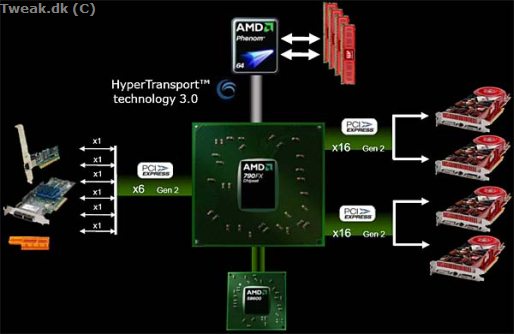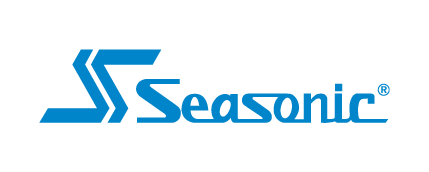Gigabyte MA790FX-DQ6 (UK)

AMD’s latest chipset has recently been released, which means that the motherboard manufactures is about ready with their new products. Gigabyte is also ready with their high-end motherboard for enthusiast, based on the new 790FX platform also known as Spider. One of the main new features about this chipset is the 42 PCI-E V2.0 lanes, providing plenty of bandwidth for Crossfire-X and Quad Core AMD Phenom.
Introduction:
AMD’s latest chipset has recently been released, which means that the motherboard manufactures is about ready with their new products. Gigabyte is also ready with their high-end motherboard for enthusiast, based on the new 790FX platform also known as Spider. One of the main new features about this chipset is the 42 PCI-E V2.0 lanes, providing plenty of bandwidth for Crossfire-X and Quad Core AMD Phenom. 
Another great thing about this platform is its backwards compatibility with CPU’s from previous generations. The Spider platform supports CPU’s based on the previous AM2 standard, as well as the new AM2+ standard. It is “pin for pin” compatible, making the board suitable for users who are interested in using Crossfire X, but still wants to hold on to their old ram and CPU.
Even though the market isn’t booming with Spider platform manufacturers, my expectations for Gigabyte are high. Gigabyte is known to be in front with solutions for enthusiast. If that’s the case this time, you’ll need to carry on reading to find out.
Specifications:
The board from Gigabyte supports the Sempron, Athlon and Phenom CPU families. Besides that, DDR2 is used on the board, which is very cheap at the moment. Actually it’s possible to get 2 GB ram for very low prices if you look the right places on the internet. Connecting this with an Athlon 4000+ X2 CPU from an old pc, you’ve got yourself a relatively cheap and fast setup.
| CPU |
|
| Hyper Transport Bus |
|
| Chipset |
• South Bridge: AMD SB600 |
| Memory |
• Dual channel memory architecture • Support for DDR2 1066(Note 2)/800/667 MHz memory modules • Support ECC Memory(Note 3) |
| Audio |
• High Definition Audio • 2/4/5.1/7.1-channel • Support for DTS (dts NEO:PC) • Support for S/PDIF In/Out • Support for CD In |
| LAN |
|
| Expansion Slots |
• 2 x PCI Express x8 slots (PCIE_8_A, PCIE_8_B) supporting ATI CrossFireX™ technology • 1 x PCI Express x1 slot • 2 x PCI slots |
All specifications can be seen here.
As we expect from the major manufacturers, nothing is missing in the specifications. Gigabyte has even managed to add their well-known DualBios feature, which enables the user to bring the board back to live in case of a faulty bios flash.
As an extraordinary feature, “Teaming” the two built-in ethernetcards is possible. The possibility of combining these cards gives you either an error tolerance, or twice the speed. The speed though, is probably only theoretically doubled, since limiting hardware like discs, other pc’s etc might come into play.
A total of 10 USB ports are possible on the Gigabyte board, where 6 of them are located on the back of the board. The last 4 can be connected through the bundled “bracket” which is mountable in a PCI slot. This amount of ports should be plenty, and USB ports are soon found in all products anyways.
The Northbridge, which is the heart of this motherboard, contains a number of new technologies, which on paper seems very attractive. The Northbridge is based on 65 micron, and with its small size, its joining the hype about energy efficiency and low power. AMD also mentions this on their website. The 790FX chipset has 42 PCI Express lanes, which is twice the amount the last generation had. But all these lanes are justified when we talk about Quad CrossFire. All 4 PCI-E ports will be used and therefore the 32 lanes will be used for graphics cards alone.
Another hyped technology is the PCI-E 2.0, which has caused a bit of confusion among graphics card buyers. These new graphics cards (3870 and 8800GT etc.) is PCI-E 2.0 compatible. The question is “What does it mean to me?”, and the question is not much since the technology is backwards compatible with the earlier generation. PCI-E 2.0 is introduced at the same time as Hypertransport 3.0, and then it starts to make sense. PCI-E 2.0 increases the speed over the buss from 500mb/sec to 1 gb/sec, which is a nice double up.
Besides that, the PCI-E 2.0 standard can close lanes or change the speed of individual lanes, which is more energy efficient. Since the graphics card and Southbridge is connected to the Northbridge, and all data must go through this, the need of Hypertransport 3.0 was required. This has also doubled from 1 gb/sec to 2 gb/sec.
Speed between north and Southbridge is done with only 4 PCI-E lanes, which allows a maximum transfer of 2 gb/sec. This might not sound like much, but all the important primary subsystems uses the Northbridge, and only leaves drives and USB functions at the Southbridge. So the 2 gb/sec should be enough.











